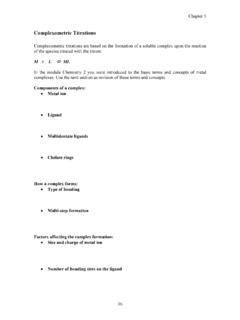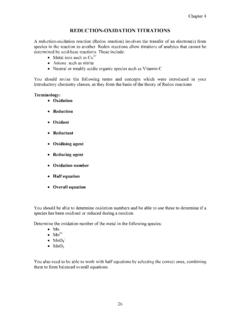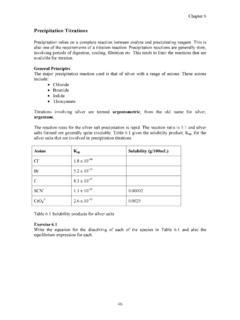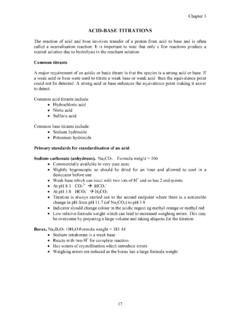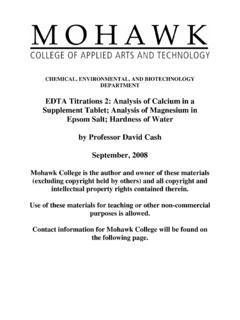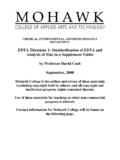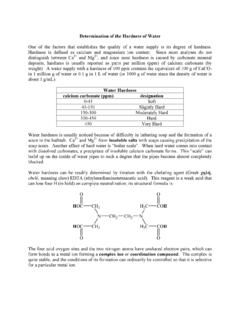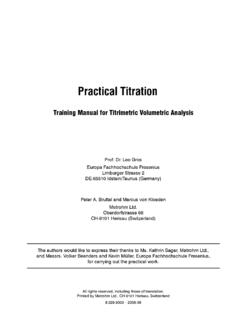Transcription of Titration Principles - cffet.net
1 Chapter2. Titration Principles General Principles Volumetric analysis refers to a collection of methods in which the volume of a solution of accurately known concentration, the standard solution, required to react quantitatively with the analyte is determined. The process is known as Titration . Standard solution is generally added from the burette (but not always). The solution in the burette is termed the titrant Equivalence point is the point at which the analyte is totally consumed Endpoint is where there is an observable change in the system such as colour change of an indicator. This point should be very close to the equivalence point. As a general rule the volume of titrant should be within 15-30 mL. Less than this volume introduces considerable relative errors and more than this volume is time and chemical consuming. Titration standards Commonly available standards, (such as sodium hydroxide and hydrochloric acid) are generally not found in an extremely pure form.
2 Solid sodium hydroxide is very hygroscopic and also absorbs carbon dioxide from the air forming sodium carbonate. Hydrochloric acid is provided as a concentrated solution of approximately known concentration. This means that it is not possible to measure out exact quantities. A primary standard enables the chemist to determine exactly the concentration of another solution which is termed the secondary standard. A primary standard should have: High purity so that the mass of material can be weighed out and the exact number of moles determined ie it must be 100% pure Stability and not degrade with time by absorption of moisture from the atmosphere or be easily oxidised Absence of hydrate water which would not allow the exact composition to be known Availability at reasonable cost Reasonable high formula mass to reduce weighing errors involved in small masses. The value of the secondary standard should remain constant for a considerable time before restandardisation is required.
3 Sodium hydroxide, a common secondary standard for the analysis of acidic solutions has been shown to change its concentration by per week during storage in a glass bottle. This is primarily due to absorption of CO2 but also due to reaction of NaOH with the glass to form sodium silicate (a compound which causes glass stoppers to freeze when used with alkaline solutions. 9. Chapter2. Reactions Used in Volumetric Analysis There are limited reactions suitable for Titration . Criteria used to define suitable titrations include: 1. Defined stoichiometry: A balanced equation must be written that describes the reaction correctly as the reaction ratio must be known for the calculations. 2. Rapid reaction rate so that a premature endpoint is not obtained by a lag in the reaction. 3. Complete reaction so that the analyte is completely consumed 4. Endpoint detection must be available to accurately determine the equivalence point Types of Volumetric Analysis Table Major types of volumetric analysis Type Mechanism Example Acid Base Involves transfer of a proton Acids in wine by Titration from the acid to the base with standard NaOH solution Oxidation Reduction Involves transfer of electron Iron II can be analysed by (commonly referred to as from one species to another oxidation with a known REDOX reactions) volume of standardised permanganate solution Precipitation Involves removal of the Analysis of salt levels by analyte as a precipitate precipitation of chloride using standard silver nitrate solution Complex formation Metal ions form complex by Determination of water bonding to ligands which hardness by Titration with have pairs of unbonded EDTA.)
4 Electrons Endpoint Determination Question: When has enough titrant been added to completely consume the analyte? Answer: At the equivalence point Question: How is this point determined? Answer: By some visual indication as indicated below 1. Addition of a colour-change indicator Addition to the Titration flask of a species which changes colour when either the titrant is in excess or the analyte disappears. (Phenolphthalein is an indicator which changes colour between pH which coincides with the equivalence point of a number of acid/base reactions The endpoint colour change and the equivalence point should be very close otherwise an indicator error is introduced Colour change should be very obvious. 10. Chapter2. 2. Self indicating reaction Ideal situation if the analyte or titrant changes colour and the change can be seen. Potassium permanganate changes from an intense purple colour to colourless when it forms manganese II ions 3.)
5 Electrical measurement of solution Where a suitable indicator is not available measurement of solution potential, current or resistance changes may be measured during a Titration . These methods provide a very accurate endpoint determination but can be costly and time consuming. (These type of measurement will be studied in Instrumental Tests 3). The endpoint detection is the most inaccurate step in a Titration . Even the best technique could not hope to determine the endpoint to a greater accuracy than mL and typically it is mL. Conversion of this into relative error (for a mL titre), , indicates it is much greater than errors introduced by weighing or pipetting. Calculations Titration calculations revolve around the number of moles of the reactants. (See chapter 4 of Calibration and Data Handling notes). Remember these formula MOLES = MASS (g) F Wt And MOLES = Molarity x Volume (L).
6 The method for calculations in volumetric analysis revolves around these equations and a balanced reaction equation. Steps in a Titration calculation Step 1 Write a balanced equation for the reaction Step 2 Calculate the number of moles of the standard reactant Step 3 Determine the number of moles of the analyte, by using the reaction ratio Step 4 Calculate the mass of the analyte (or the unit required). 11. Chapter2. Example: A solution of approximately M HCl is standardised with Na2CO3. g of NasCO3. requires mL of the HCl to reach endpoint. The HCl is then used to titrate a solution of NaOH. mL of the base solution is titrated to endpoint by mL of the acid. What is the concentration of the NaOH? Part I. Step 1: write the balanced equation for the reaction Step 2: calculate the number of moles of the standard reactant (you must firstly decide which species is the standard and which is the analyte).
7 Step 3: determine the number of moles of the analyte by using the reaction ratio Step 4: Calculate the concentration Part 2. Step 1: write the balanced equation for the reaction Step 2: calculate the number of moles of the standard reactant (you must firstly decide which species is the standard and which is the analyte). Step 3: determine the number of moles of the analyte by using the reaction ratio Step 4: Calculate the concentration 12. Chapter2. Back titrations Reactions which are slow or produce side-reactions can prove difficult for Titration . For example: calcium carbonate is a water insoluble base. It will react with HCl but provides a false endpoint as the HCl reacts with the solid Ammonia is a gas not completely soluble in water with some of the gas lost as a gas. Vitamin C (ascorbic acid) is stable in the solid state but is readily oxidised in solution by the oxygen in the air.
8 Any attempt to titrate a solution of it with an oxidising titrant such as iodine or permanganate will be inaccurate because the analyte is not only reacting with the titrant. The procedure known as back Titration enables analyses such as those listed above to be conducted with a high level of accuracy. A known amount of some reagent which reacts with the analyte is added and a Titration of the left over reagent is done. The analyte is not titrated. The method overcomes slow reactions and side reactions. The calculations are a little more complicated, but not more difficult if an understanding of the process occurs. Use the following example to gain an understanding of the process. You will gain practise in the method during the practical sessions. In the analysis of limestone for calcium carbonate: Dissolution will not occur in water but it will occur in HCl HCl becomes the solvent Excess HCl is quantitatively added to the limestone HCl reacts with the calcium carbonate (it may require gentle heating to speed up the reaction and drive off the carbon dioxide).
9 Some HCl remains Amount of HCl remaining is determined by Titration with standard NaOH. Number of moles of CaCO3 in the original sample are calculated. Steps in a back Titration calculation Step 1 Write a balanced equation for both reactions Step 2 Calculate the number of moles of the standard solvent added to the sample Step 3 Calculate the moles of titrant used in the back Titration Step 4 Calculate the moles of solvent that reacted in the back Titration Step 5 Calculate the moles of solvent that reacted with the analyte (Step 2-Step4). Step 6 Calculate the moles of analyte that reacted with the solvent . Step 7 Calculate the mass of analyte 13. Chapter2. Example: The content of calcium carbonate, an insoluble basic analyte in limestone, is analysed by back Titration . g of the sample is powdered and dissolved in mL HCl solution. The reaction mixture is heated and stirred to ensure a rapid and complete reaction between the CaCO3 and the HCl.
10 After cooling, the remaining HCl is back titrated with mL of M NaOH. Step 1 Write a balanced equation for both reactions Step 2 Calculate the number of moles of the standard solvent added to the sample Step 3 Calculate the moles of titrant used in the back Titration Step 4 Calculate the moles of solvent that reacted in the back Titration Step 5 Calculate the moles of solvent that reacted with the analyte (Step 2-Step4). Step 6 Calculate the moles of analyte that reacted with the solvent . Step 7 Calculate the mass of analyte 14. Chapter2. Advantages and Disadvantages of Titrimetric Analysis Time: Requires a standardisation step to obtain the exactly known concentration of the standard solution Individual Titration is generally rapid and should be completed within 10 minutes, excluding sample preparation. Sensitivity: Requires fairly concentrated samples to be successful.
